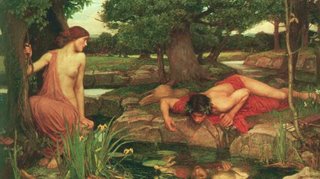Echo and Narcissus, John William Waterhouse, 1903.
The parable of Narcissus has been a rich vein for artists to mine for at least two thousand years, beginning with the Roman poet Ovid (book III of Metamorphoses). This was followed in more recent centuries by other poets (Keats), and painters (Caravaggio, Poussin, Turner, Dalí, and Waterhouse).
In Stendhal's novel Le Rouge et le Noir (1830), there is a classic narcissist in the character of Mathilde. Says Prince Korasoff to Julien Sorel, the protagonist, with respect to his beloved:
She looks at herself instead of looking at you, and so doesn't know you. During the two or three little outbursts of passion she has allowed herself in your favor, she has, by a great effort of imagination, seen in you the hero of her dreams, and not yourself as you really are. (Page 401, 1953 Penguin Edition, trans. Margaret R.B. Shaw).
The myth had a decided influence on English Victorian homoerotic culture, via the influence of Andre Gide's study of the myth Traite du Narcisse ('The Treatise of the Narcissus', 1891), and the influence of Oscar Wilde. Also, many characters in Fyodor Dostoevsky's (19th-Century Russian Writer) writings are lonely Narcissus-types, such as Yakov Petrovich Golyadkin in "The Double" (Published 1846).
In Stendhal's novel Le Rouge et le Noir (1830), there is a classic narcissist in the character of Mathilde. Says Prince Korasoff to Julien Sorel, the protagonist, with respect to his beloved:
She looks at herself instead of looking at you, and so doesn't know you. During the two or three little outbursts of passion she has allowed herself in your favor, she has, by a great effort of imagination, seen in you the hero of her dreams, and not yourself as you really are. (Page 401, 1953 Penguin Edition, trans. Margaret R.B. Shaw).
The myth had a decided influence on English Victorian homoerotic culture, via the influence of Andre Gide's study of the myth Traite du Narcisse ('The Treatise of the Narcissus', 1891), and the influence of Oscar Wilde. Also, many characters in Fyodor Dostoevsky's (19th-Century Russian Writer) writings are lonely Narcissus-types, such as Yakov Petrovich Golyadkin in "The Double" (Published 1846).


<< Accueil